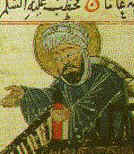7th century
The century VII d. C. (7th century AD) or VIIth century and. c. (seventh century of the Common Era) began on January 1, 601 and ended on December 31, 700. It is called the "Century of Islam."
During this century, the Prophet Muhammad founded Islam in present-day Arabia, from then on, the so-called Muslim expansion began, throughout the century, Muslims would conquer territories belonging to the Sassanid Empire, which it disappeared in 651 assimilated by the new Muslim empire. For their part, the Byzantines would suffer a multitude of problems due to the expansion of the Arabs, but it was not all bad news for the Eastern Roman Empire, its capital Constantinople became the largest city in the world and one of the most influential. In Western Europe, the so-called Dark Age began, which will continue until the reign of Charlemagne. In the Visigothic Kingdom of Toledo. Another important event that took place during this century was the Councils of Toledo.
In China, the Tang Dynasty replaced the Sui Dynasty, ushering in a heyday of Chinese civilization and a golden age of the Empire's cosmopolitan culture, which in turn achieved great technological and scientific advances.
Relevant events
Wars and Politics
- 603: Last mention of the Roman Senate.
- 615: The Sassanian Empire, led by King Cosroes II, plunders Jerusalem and takes the Vera Cross.
- 618: Tang dynasty is made with power in China.
- 622: Hegira of the Moslems of Mecca towards Medina. This date is the beginning of the Muslim lunar calendar.
- 626: The Avarites, the Slavs and the Sassanian Empire are united in an attempt to take Constantinople, but they fail conceitably.
- 627: The Emperor Heraclio defeats the Persians-Sasanids by ending the Roman-Sasanid Wars.
- 632: The so-called Muslim expansion begins.
- 634: The Arab-Byzantine Wars begin, many Byzantine territories will be conquered by the Arabs.
- 636: In the Battle of al-Qadisiyya, the Arabs decisively overcome the Sassanids.
- 637: The Arabs conquer Jerusalem and the following year all Palestine.
- 642: The Arabs conquer the Roman province of Egypt, ending with almost 1000 years of Greek-Roman domination (from the conquest of Persian Egypt at the hands of Alexander the Great in 332 B.C.)
- 651: The Sassanian Empire disappears after the murder of Yazdgerd III and the taking of Ctesifonte by the Arabs. The region of Iran will be governed by foreign forces until the rise of the Safavid Empire in the sixteenth century.
- 657: The Chinese Empire defeats the Western Turks, significantly expanding their territory.
- 661: After the murder of Ali Ibn Abi Talib the Second Caliphate is established.
- 664: Muslims conquer Kabul (present-day Afghanistan)
- 674-678: The Arabs begin the siege of Constantinople, the Byzantines triumph thanks largely to the Greek fire.
- 680: The Omeya caliphate murders the relatives of Mohammed in the Battle of Kerbala.
- 682: Western Turks regain their independence from China and establish a new Kanato.
- 690: The Wu Zetian consort is made with the power of China and establishes the ephemeral Dynasty Zhou.
- 697: Paolo Lucio Anafesto is chosen as the first Dux of Venice to start the Republic of Venice, one of the longest States in history (which will exist until the Italian campaign of Napoleon Bonaparte exactly 1100 years later)
- 688: The Byzantine Emperor Justinian II defeats the Bulgarians.
- 698: The Arabs capture Cartago, a city in the hands of the Byzantines.
- 698: The North and South State Period in Korea begins.
Disasters
- Teotihuacán is looted, his religious and political buildings are rooted.
- 694: The Visigoth King Egica accuses the Jews of collaborating with the Muslims and condemns them to slavery.
Religion
- 622: Mohammed founded the religion of Islam with his preaching in the Arab world.
- 691: Buddhism becomes the official religion of China.
Culture and science
- Guangzhou, China, becomes the world's most international port.
- 610: Heraclio, Byzantine emperor, establishes the Greek for Latin as the official language of the Eastern Roman Empire.
- 630-1: Emperor Songtsen Gampo marries two Buddhist princesses (a Nepalese and one Chinese), which led to the introduction of Buddhism in Tibet, as well as the consolidation of Tibetan alphabet.
Relevant people
- Abu Bakr as-Siddiq (573-634): First Islam caliph.
- Ali ibn Abi Talib (599/600-661): Primo de Mohammed and first Imán de los Chiitas.
- Asparukh of Bulgaria (-700): Founder of the First Bulgarian Empire.
- Berta de Kent (539-612): Princess Merovingia, famous for introducing Christianity in England.
- Bonifacio (680-754): Holy and martyr of English origin.
- Brahmagupta (598-668): Hindu Mathematics.
- Caedmon (-680): English Poet.
- Heraclio (575-641): Byzantine Emperor, famous for his struggles against the Sassanian Empire.
- Muhammad (570/571-632): Prophet of Islam.
- Pacal el Grande (603-683): Mayan governor.
- Úmar ibn al-Jattab (586/590-640): Second Orthodox caliph of Islam.
- Uthmán ibn Affán (576-656) Third Orthodox caliph of Islam
- Wu Zetian (625-705): Unique empress of Chinese history.
- Yazdgerd III (-651): Ultimate ruler of the Sassanian Empire.
Contenido relacionado
Annex: Annual table of the 19th century
Charles Linnaeus
Stephen I of Hungary


